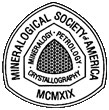|
Habit is the general appearance a mineral tends to
have – whether it is found as blocky crystals, long slender ones, or
aggregates of some type, etc. If the crystals are glassy but cubic in
shape you know they aren’t quartz. If they are rounded like a soccer
ball you know they aren’t tourmaline. And so on…
Distinct crystals may be described as:

|
Blocky or Equant – Roughly box-like or ball-like, as in pyrite.
|
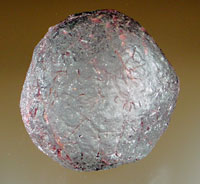 |
| Rhodolite garnet, 8 cm across,
Brazil |
|
| |

|
Tabular - Shaped like a pad of paper (thin tabular) or a deck of playing cards (thick tabular).
|
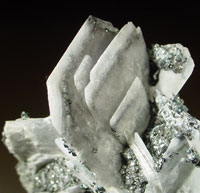 |
| Barite 4cm across,
Bolivia |
|
| |

|
Prismatic – Elongated with opposite faces parallel to one another, in
which case they may be short and stout, or long and thin. Includes minerals
such as quartz and tourmaline crystals
|
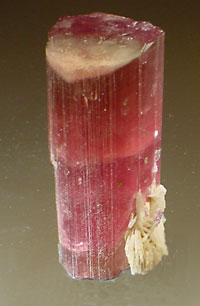 |
| Tourmaline (elbaite) 9 cm tall, California |
|
| |

|
Bladed - Long thin crystals may be flattened like the blade of a knife.
Actinolite is often bladed.
|
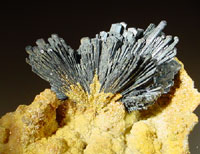 |
| Stibnite, 5cm across, Romania |
|
| |

|
Acicular – Needle-like.
|
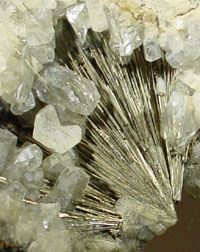 |
| Millerite, 1.5cm. long,
Wisconsin |
|
| |

|
Filiform or Capillary – Like hair or thread.
|
 |
| Pyrite filament 0.2 mm
long, New Mexico, Dan Behnke photograph |
|
Groups of distinct crystals may be described as:

|
Druzy - Covering a surface in more-or-less outward pointing clusters of
small crystals, such as druzy quartz crystals.
|
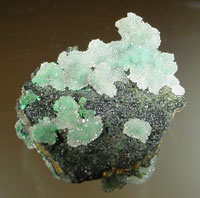 |
| Quartz on chrysocolla, Mexico 2cm across |
|
| |

|
Divergent or Radiating - Growing outward from a point in sprays or
starbursts, such as some hemimorphite exhibits.
|
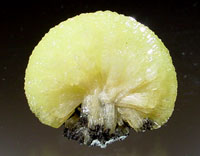 |
Adamite 3.5 cm across,
Mexico |
|
| |

|
Reticulated – Interconnected like a lattice or trellis, such as rutile.
|
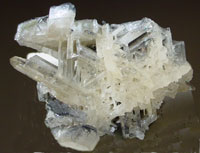 |
Cerussite, Tsumeb, Namibia
2 cm across |
|
| |

|
Dendritic or Arborescent - Slender divergent branch- or fern-like
clusters, such as some native silver crystals.
|
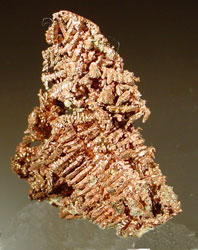 |
| Copper, Michigan, 4cm
tall |
|
Compact parallel or
radiating groups of individual crystals may be described as:

|
Columnar – Stout parallel clusters with a column-like appearance, such
as some forms of the serpentine minerals.
|
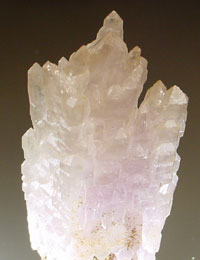 |
| Quartz, 4cm tall, New Mexico |
|
| |

|
Fibrous – Aggregates of parallel or radiating slender fibers, such as
chrysotile.
|
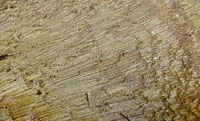 |
| Silver 2cm across, Czech Republic |
|
| |

|
Stellate – Long thin crystals radiating outwards in all directions, like
a starburst or in a circular pattern, such as astrophyllite.
|
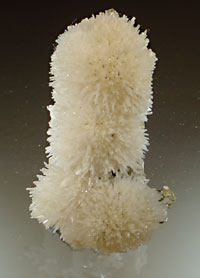 |
| Natrolite, 10 cm tall, Tasmania, Australia |
|
| |

|
Spherical or Globular – Compact clusters radiating outwards forming
rounded, ball-like, shapes.
|
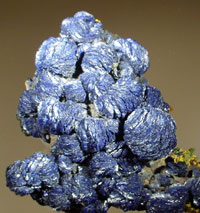 |
| Azurite, 10cm across, Arizona |
|
| | The next three habits tend to grade into each other |

|
Botryoidal – Globular or ball-like clusters – like a bunch of grapes.
|
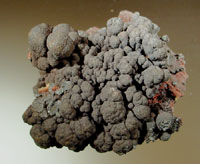 |
| Hematite, 2cm across,
Wisconsin |
|
| |

|
Mammillary – Large rounded masses resembling human breasts.
|
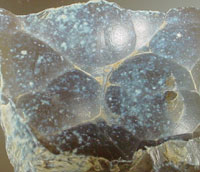 |
| Quartz variety chalcedony, 4cm across,
Nebraska |
|
| |

|
Reniform – Radiating compact clusters of crystals ending in
rounded, kidney-like, surfaces, such as hematite often exhibits.
|
 |
| Hematite 6 cm across, Wisconsin |
|
A
mineral aggregate composed of scales or flakes may be described as:

|
Foliated – Looking like overlapping flakes or leaves and easily
separable into individual leaves or flakes, usually at least somewhat "wavy"
in appearance, such as the chlorite minerals.
|
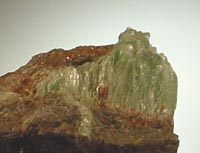 |
| Talc, 6 cm across, Michigan |
|
| |

|
Micaceous – Like foliated, but splits into very thin sheets, like the
mica minerals.
|
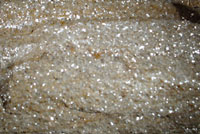 |
Mica schist, Black Hills,
South Dakota, 10cm across |
|
| |

|
Lamellar – Flat, platy, grains thicker than flakes or leaves,
but overlapping like foliated, such as molybdenite.
|
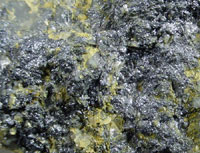 |
Molybdenite &
ferrimolybdenite (yellow),
Canada 3cm across. |
|
| |

|
Plumose – Feather-like sprays of fine scales, similar to dendritic but
with a much finer structure, such as one form of native silver.
|
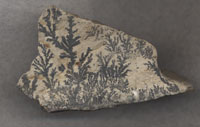 |
| Manganese oxide dendrites, Grant Co. New Mexico 6 cm
across |
|
A
mineral composed of grains is simply said to be granular. Granular minerals
may be composed of rounded or semi-rounded grains, or of angular grains.
A few other descriptive terms are:

|
Massive – No crystal structure visible, though the mineral may be
crystalline. Some massive minerals may also be granular.
|
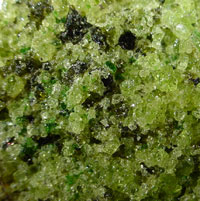 |
Forsterite and magnetite,
Arizona 3cm across |
|
| |

|
Banded – Showing different bands or layers of color or texture, as
in some agates or some fluorite.
|
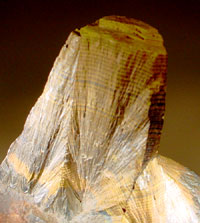 |
| Goethite, 8 cm tall, Wisconsin |
|
| |

|
Concentric – In rounded masses showing layers around the mass in shells,
working outward from the center, as in some agates.
|
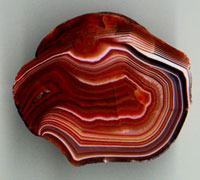 |
| Quartz var. Lake Superior agate, 5 cm across, Michigan |
|
| | The next three habits tend to grade into each other,
oolites and pisolites tend to be uncommon |

|
Oolitic – Masses of small round spheres about the size of fish eggs
(0.25-2.0mm).
|
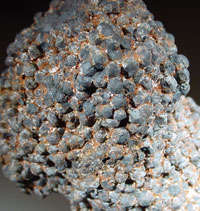 |
| Manganese oxide, 3cm across, Australia |
|
| |

|
Pisolitic - Roughly pea-size rounded masses.
|
 |
| Manganese oxide, 6cm across, Australia |
|
| |

|
Concretionary – Masses formed by mineral being deposited around a
nucleus, may be spherical or rounded but may also be a wide variety of other
shapes.
|
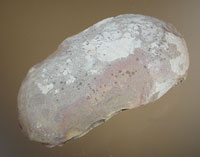
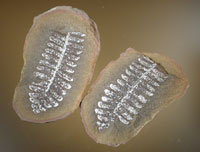 |
Top - outside of concretion,
2cm across, Illinois;
Bottom - interior of split
concretion showing fern leaf fossil |
|
| |

|
Geode – A rock with a hollow, roughly spherical, interior with
concentric bands of mineral (usually agate) on the wall and possibly
crystals on the interior surface, pointing inwards.
|
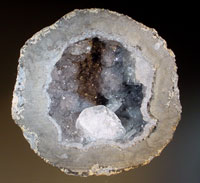 |
| Geode, with quartz and calcite
crystals, 8cm across, Mexico |
|
A wide variety of other terms are also used to describe
mineral habits. Usually they refer to loose associations with common
objects or concepts and are readily apparent when the term is used in context
with the form present in the mineral at hand.
[ Table
of Contents ] [ Introduction
] [ Identification
Kit ] [ Mineral
Properties ] [ Environments
& Associations ] [ In
Conclusion ] [ The
Mineral ID Key ]
[Previous] [Next]
|
